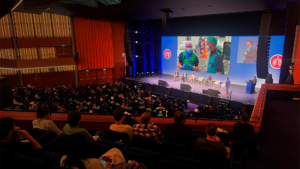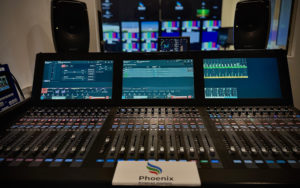Telycam – How to choose a camera for your lightweight event/production

Video production and live streaming have become essential methods for spreading ideas and storytelling in today’s landscape. The broadcast industry is evolving, shifting towards more accessible means of communication. Navigating a lightweight event or production journey demands striking the right balance between portability and performance.
With consumers increasingly demanding higher quality video content, cameras play a crucial role in capturing vivid live scenes. PTZ cameras, with their versatility and performance, are adept at meeting these evolving demands, catering to the dynamic needs of content creators and broadcasters.
Key specs you should care about
The fundamental principle underlying a PTZ camera is akin to that of other digital cameras: the lens captures the image, transmitting it to the sensor where the light signal undergoes conversion into an electric signal. Subsequently, the final image is rendered by the Image Signal Processor (ISP) following intricate algorithms and processing.
The ISP serves as the ‘brain’ of a camera. Analogous to the human brain’s role in perception, the ISP plays a crucial role in processing images captured by the sensor. Its functions include demosaic, denoising, auto exposure, auto white balance, auto focus, black level correction, color correction, gamma correction, and more, ultimately presenting a refined and enhanced final image.
The sensor plays a crucial role in transforming light signals into electrical signals for further processing and storage, making it pivotal in determining image quality. Among sensor types, CMOS sensors are widely favored in both digital still cameras and PTZ cameras due to their lower power consumption, superior image quality, and cost-effectiveness; larger sensors generally yield better image quality. This is because sensor size directly influences the amount of light captured. During video capture, each pixel on the sensor records light information, with larger sensors typically offering higher dynamic range, wider ISO range, and reduced noise. Notably, larger sensors excel in capturing finer details and maintaining optimal exposure in challenging lighting conditions, while also exhibiting less noise in low-light environments. Incorporating larger CMOS sensors into PTZ cameras yields a cinematic final video effect.
The lens is responsible not only for filtering out unwanted light but also for determining a critical specification: aperture. By adjusting the aperture, we can regulate the amount of light reaching the sensor. A larger aperture offers distinct advantages, particularly in low-light conditions or night vision scenarios. The aperture also influences the depth-of-field effect. During video production, a pronounced bokeh effect both accentuates the focal point of the narrative and contributes to the creation of visually stunning scenes.
Beyond hardware, software algorithms are pivotal in determining video quality, fine-tuning color, tone, contrast, noise reduction, and more to craft the final video output. Different companies’ software algorithms produce diverse imaging effects and styles. Exceptional software algorithms are essential for optimizing videos across different application environments.
Customized requirements for different applications

In the realm of video production, many users and broadcasters continue to favor traditional HDMI or SDI transmission due to its proven reliability. Traditional digital transmission offers uncompressed video with high quality and minimal latency. However, drawbacks include costly cabling installation and limited transmission distance. In Telycam’s latest Explore PTZ series, we’ve incorporated an SFP+ port, allowing for enhanced scalability through the conversion of SDI signals to fiber optics. This extends transmission distances and reduces costs.
We’ve witnessed numerous successful user stories as they transition from traditional digital production workflows to AV over IP and even cloud-based production. With several protocols vying for a role in cloud-based operations, SRT stands out as an open-source video streaming protocol tailored for secure, high-quality, and low-latency point-to-point video transmission across the public internet. As technology progresses, NDI 6 is poised for release, addressing multi-point video/audio/control transmission over WAN. All Telycam NDI/IP series PTZ cameras now support the SRT protocol. As a strategic partner of NDI, Telycam will be the first vendor to implement NDI 6 into its PTZ camera line.
PTZ cameras are extensively utilized in live events across churches, studios, and theaters, where lighting conditions are often complex, and hosts or performers frequently move around the stage. These demanding scenarios necessitate cameras with superior low-light performance and rapid autofocus capabilities to capture dynamic effects seamlessly. Telycam’s Explore PTZ camera, equipped with a 1-inch sensor, delivers exceptional low-light performance, ensuring optimal image quality even under challenging stage lighting. Furthermore, its Phase Detection Autofocus (PDAF) technology enables lightning-fast focusing, allowing the 20x optical zoom PTZ camera to capture every moment with precision. PDAF utilizes phase differences in light rays to enhance autofocus performance, ensuring sharp and clear images in any setting.
In the realm of video production, one undeniable trend is the integration of VR/AR production into enterprise and corporate studios, no longer limited to big TV stations or high-end live shows. To embrace this evolution, Telycam has integrated the FreeD protocol into its current PTZ camera lineup, spanning from the ProAV level Vision+ series to the broadcast-level Explore series. The Explore series offers FreeD support through both NDI|HX/IP and 12G-SDI connections. With the inclusion of Genlock, the Explore series ensures seamless camera data transmission to VR/AR software. Genlock proves invaluable in multi-camera setups, particularly in green-screen studios where real-world elements are integrated into virtual scenes, preventing any discrepancies in timecode when transitioning between camera feeds.
As video production continues to evolve, embracing new technologies and trends becomes imperative for staying competitive, for both vendors and users. The future trend of the PTZ cameras market and the live production industry is likely to be shaped by several key factors, including advancements in hardware and software technology, integration of Artificial Intelligence, the increased adoption of IP-based workflows and transition to cloud production and immersive virtual production. The current PTZ camera is renowned for its portability and user-friendly design, making it accessible even to volunteers and newcomers in settings like churches. Its ease of use ensures quick mastery of basic functions, contributing to successful shows. This advantage is expected to persist even as more new technologies are integrated into PTZs.









